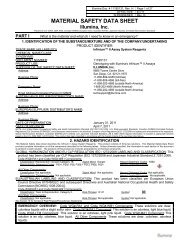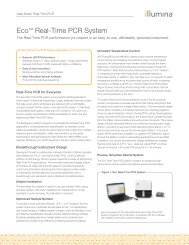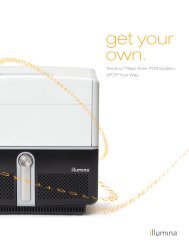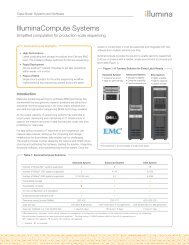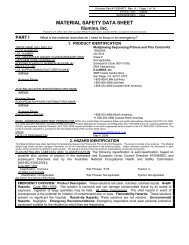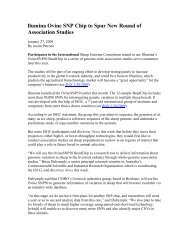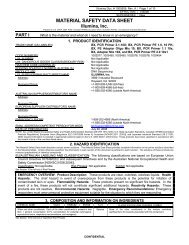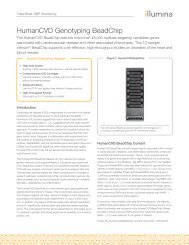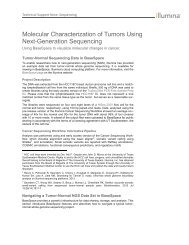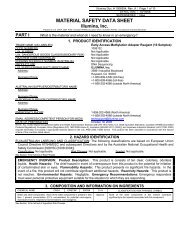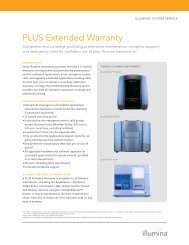Flow Cell - Illumina
Flow Cell - Illumina
Flow Cell - Illumina
You also want an ePaper? Increase the reach of your titles
YUMPU automatically turns print PDFs into web optimized ePapers that Google loves.
PART I<br />
<strong>Illumina</strong> Doc. # 1005221, Rev. A Page 1 of 10<br />
EFFECTIVE: 6/22/08<br />
SUPERSEDES: New<br />
MATERIAL SAFETY DATA SHEET<br />
<strong>Illumina</strong>, Inc.<br />
Prepared to U.S. OSHA, CMA, ANSI, Canadian WHMIS, European Union, Australian NOHSC, and Japanese Industrial Standards<br />
What is the material and what do I need to know in an emergency?<br />
1. PRODUCT IDENTIFICATION<br />
TRADE NAME (AS LABELED):<br />
Activated Grafted FC Single Read; FC, PE Activated<br />
2Primer V2.0; FC, 1.4MM, SR; FC, 1.4MM, PE; IFC, 1.4mm<br />
SR, PhiX; IFC, 1.4mm PE, PhiX; PhiX 1G Install FC<br />
CODE NUMBERS: 0801-1150; 1003219; 1004224; 1004225; 1004228; 1004230;<br />
1002810<br />
U.N. NUMBER:<br />
Not Applicable<br />
U.N. DANGEROUS GOODS CLASS/SUBSIDIARY RISK: Not Applicable<br />
HAZCHEM CODE (AUSTRALIA):<br />
Not Applicable<br />
POISONS SCHEDULE NUMBER (AUSTRALIA):<br />
Not Applicable<br />
PRODUCT USE:<br />
DNA Sequencing<br />
U.S. SUPPLIER/MANUFACTURER'S NAME:<br />
ILLUMINA, Inc.<br />
Address:<br />
25861 Industrial Boulevard<br />
Business Phone:<br />
AUSTRALIAN SUPPLIER/DISTRIBUTOR'S NAME:<br />
Address:<br />
Business Phone:<br />
EUROPEAN SUPPLIER/ DISTRIBUTOR'S NAME:<br />
Address:<br />
Hayward, CA 94545<br />
+1-800-809-ILMN (toll-free)<br />
+1-800-809-4566 (toll-free)<br />
+1-858-202-4566 (outside North America)<br />
Business Phone:<br />
EMERGENCY PHONE:<br />
1-858-202-4566 (North America)<br />
+1-858-202-4566 (outside North America)<br />
EMAIL ADDRESS/COMPETENT PERSON FOR MSDS: techsupport@illumina.com<br />
DATE OF PREPARATION: June 22, 2008<br />
NOTE: ALL United States Occupational Safety and Health Administration Standard (29 CFR 1910.1200), U.S. State equivalent Standards, Canadian WHMIS [Controlled<br />
Products Regulations], European Union [Regulation (EC) 1907/2006 Annex II], Australian [NOHSC:2011 (2003)], and Japanese Industrial Standard (JIS Z 7250:<br />
2000) required information is included in appropriate sections based on the U.S. ANSI Z400.1-2004 format. These products have been classified in accordance with<br />
the hazard criteria of the countries listed above.<br />
2. HAZARD IDENTIFICATION<br />
This Material Safety Data sheet describes various flowcells. The flowcells consist of glass slides with channels, inside each channel there is a buffer solution and a<br />
coating of DNA and polyacrylamide on the glass. This Material Safety Data Sheet provides complete information on the buffers in the flowcells described in the<br />
following tables. Unless otherwise specified, the information in each section of this document is pertinent to each solution. The solutions of these products are<br />
mixtures (preparations) of chemical compounds.<br />
EU/AUSTRALIAN LABELING AND CLASSIFICATION: The following classifications are based on European Union<br />
Council Directive 67/548/EEC and subsequent Directives and by the Australian National Occupational Health and<br />
Safety Commission [NOHSC(1008:2004)].<br />
Classification: Not applicable. Risk Phrases: Not applicable. Symbol: Not applicable.<br />
See Section 16 for full text of Risk Phrases<br />
EMERGENCY OVERVIEW: Product Description: These products consist of glass slides with channels. Inside<br />
each channel there is a buffer solution and a coating of DNA and polyacrylamide on the glass. The buffer solutions<br />
are clear, colorless, odorless liquids. Health Hazards: The chief hazard in event of overexposure from these<br />
products is the potential for irritation of contaminated skin or eyes. Flammability Hazards: The buffer solutions<br />
present no significant fire hazards. In the event of a fire, these products will not contribute significant additional<br />
hazards. Reactivity Hazards: These products are not reactive. Environmental Hazards: Negligible.<br />
Emergency Recommendations: Emergency responders must wear personal protective equipment suitable for<br />
the situation to which they are responding.
<strong>Flow</strong>cells <strong>Illumina</strong> Doc. # 1005117, Rev. A Page 2 of 10<br />
3. COMPOSITION AND INFORMATION ON INGREDIENTS<br />
CHEMICAL NAME CAS # EINECS# ENCS# % v/v CLASSIFICATION, RISK PHRASES, SYMBOL<br />
Alkali Metal Salt Proprietary 1–5 HAZARD CLASSIFICATION: Not applicable.<br />
RISK PHRASES: Not applicable.<br />
Hydroxyalkanoic Acid Salt Proprietary 1–5 HAZARD CLASSIFICATION: Not applicable.<br />
RISK PHRASES: Not applicable.<br />
Water and other constituents. Each of the other constituents is present in less<br />
than 1 percent concentration (0.1% concentration for potential carcinogens,<br />
reproductive toxins, respiratory tract sensitizers, and mutagens).<br />
See Section 16 for full text of Ingredient Risk Phrases<br />
PART II<br />
Balance<br />
None of the other constituents in this mixture contribute<br />
significantly to the hazards associated with this component.<br />
What should I do if a hazardous situation occurs?<br />
4. FIRST-AID MEASURES<br />
Contaminated individuals must seek medical attention if any adverse effect occurs. Rescuers should be taken for<br />
medical attention if necessary. Remove or cover gross contamination to avoid exposure to rescuers. Take a copy<br />
of label and MSDS to physician or health professional with the contaminated individual.<br />
SKIN EXPOSURE: If the solutions contaminate the skin, begin decontamination with copious amounts of running<br />
water. Minimum flushing is for 15 minutes. Do NOT interrupt flushing. Remove exposed or contaminated clothing,<br />
taking care not to contaminate eyes. Contaminated clothing must be removed and laundered before re-use. The<br />
contaminated individual must seek medical attention if any adverse effect develops after the area is flushed.<br />
EYE EXPOSURE: If the solutions contaminate the eyes, open victim's eyes while under gently running water. Use<br />
sufficient force to open eyelids. Have the contaminated individual "roll" eyes. Minimum flushing is for 15 minutes.<br />
Do NOT interrupt flushing. The contaminated individual must seek medical attention if adverse effects occur after<br />
flushing.<br />
INHALATION: If vapors, mists or sprays from these solutions are inhaled, remove contaminated individual to fresh air.<br />
If necessary, use artificial respiration to support vital functions. Seek medical attention if adverse effect continues<br />
after removal to fresh air.<br />
INGESTION: If these products are swallowed, CALL PHYSICIAN OR POISON CONTROL CENTER FOR MOST<br />
CURRENT INFORMATION. DO NOT INDUCE VOMITING unless directed by medical personnel. Have<br />
contaminated individual rinse mouth with water. Never induce vomiting or give diluents (milk or water) to someone<br />
who is unconscious, having convulsions, or unable to swallow. If vomiting occurs, lean patient forward or place on<br />
left side (head-down position, if possible) to maintain an open airway and prevent aspiration. If contaminated<br />
individual is convulsing, maintain an open airway and obtain immediate medical attention.<br />
MEDICAL CONDITIONS AGGRAVATED BY EXPOSURE: Pre-existing dermatitis, other skin conditions, respiratory<br />
conditions, and liver disorders may be aggravated by overexposure to components of these products.<br />
RECOMMENDATIONS TO PHYSICIANS: Treat symptoms and eliminate overexposure.<br />
FLASH POINT: Not flammable.<br />
AUTOIGNITION TEMPERATURE: Not applicable.<br />
FLAMMABLE LIMITS (in air by volume, %):<br />
(LEL): Not established.<br />
(UEL): Not established.<br />
5. FIRE-FIGHTING MEASURES<br />
FIRE EXTINGUISHING MATERIALS: In the event of a fire, use<br />
suppression methods for surrounding materials (e.g., water spray, dry<br />
chemical, carbon dioxide, foam, Halon, any “ABC” class extinguisher).<br />
FIRE EXTINGUISHING MATERIALS NOT BE USED: None known.<br />
UNUSUAL FIRE AND EXPLOSION HAZARDS: When involved in a fire,<br />
these product’s components will decompose and produce irritating<br />
vapors and toxic gases (including carbon oxides, nitrogen oxides, sodium<br />
oxides, and hydrogen chloride).<br />
Explosion Sensitivity to Mechanical Impact: Not sensitive.<br />
Explosion Sensitivity to Static Discharge: Not sensitive.<br />
SPECIAL FIRE-FIGHTING PROCEDURES: Move containers from fire<br />
Hazard Scale: 0 = Minimal 1 = Slight 2 = Moderate<br />
3 = Serious 4 = Severe<br />
area if it can be done without risk to personnel. Incipient fire responders should wear eye protection. Structural<br />
firefighters must wear Self-Contained Breathing Apparatus and full protective equipment. Chemical resistant<br />
clothing may be necessary. If possible, prevent runoff water from entering storm drains, bodies of water, or other<br />
environmentally sensitive areas.<br />
HEALTH<br />
NFPA RATING<br />
1<br />
FLAMMABILITY<br />
0<br />
OTHER<br />
0<br />
INSTABILITY
<strong>Flow</strong>cells <strong>Illumina</strong> Doc. # 1005117, Rev. A Page 3 of 10<br />
6. ACCIDENTAL RELEASE MEASURES<br />
SPILL AND LEAK RESPONSE: Trained personnel using pre-planned procedures should respond to uncontrolled<br />
releases. Proper protective equipment should be used. In case of a spill, clear the affected area and protect people.<br />
The atmosphere must have levels of constituents lower than those listed in Section 8, (Exposure Controls and<br />
Personal Protective Equipment), if applicable, and have at least 19.5 percent oxygen before personnel can be<br />
allowed into the area without Self-Contained Breathing Apparatus (SCBA).<br />
Small Spills: Lightweight gloves, a lab coat, and eye protection should be worn. Absorb spilled liquid with paper towels. Wash<br />
contaminated area with soap and water, absorb with paper towels, and rinse with water.<br />
Large Spills: Minimum Personal Protective Equipment should be Level C: triple-gloves (rubber gloves and nitrile gloves over<br />
latex gloves), chemical resistant suit and boots, hard hat, and Air-Purifying respirator with organic vapor cartridge.<br />
Self-Contained Breathing Apparatus must be selected if release occurs in confined or poorly ventilated areas or in<br />
situations in which the level of oxygen is below 19.5%. Absorb spilled liquid with polypads or other suitable absorbent<br />
materials. Dike or otherwise contain spill and remove with vacuum truck or pump to storage/salvage vessels. Decontaminate<br />
the area thoroughly. Prevent material from entering sewer or confined spaces, waterways, soil or public waters. Monitor area<br />
and confirm levels are bellow exposure limits given in Section 8 (Exposure Controls-Personal Protection), if applicable, before<br />
non-response personnel are allowed into the spill area.<br />
Place all spill residue in a double plastic bag or other containment and seal. Decontaminate the area thoroughly. Do<br />
not mix with wastes from other materials. Dispose of in accordance with applicable Federal, State, and local<br />
procedures (see Section 13, Disposal Considerations). For spills on water, contain, minimize dispersion and collect.<br />
Dispose of recovered material and report spill per regulatory requirements.<br />
PART III How can I prevent hazardous situations from occurring?<br />
7. HANDLING and STORAGE<br />
SAFE WORK AND HYGIENE PRACTICES: As with all chemicals, avoid getting these products ON YOU or IN YOU.<br />
Wash thoroughly after handling these products. Avoid splashing or spraying these products. Do not eat or drink<br />
while handling these products.<br />
STORAGE AND HANDLING PRACTICES: All employees who handle this material should be trained to handle it<br />
safely. Avoid breathing vapors or mists generated by these products. Ensure containers of these products are<br />
properly labeled. Open containers slowly on a stable surface. Store vials as directed in the product insert. Store<br />
away from incompatible materials. Material should be stored in secondary containers, as appropriate. Keep vials<br />
tightly closed when not in use. Inspect vials containing these products for leaks or damage. Read instructions<br />
provided with these products prior to use.<br />
SPECIFIC USE(S): These products are for use in laboratory biological research. Follow all industry standards for<br />
use.<br />
PROTECTIVE PRACTICES DURING MAINTENANCE OF CONTAMINATED EQUIPMENT: Follow practices<br />
indicated in Section 6 (Accidental Release Measures). Make certain that application equipment is locked and<br />
tagged-out safely, as applicable. Collect all rinsates and dispose of according to applicable Federal, State, and local<br />
procedures standards.<br />
8. EXPOSURE CONTROLS - PERSONAL PROTECTION<br />
VENTILATION, ENGINEERING, AND OCCUPATIONAL EXPSOURE CONTROLS: Use with adequate ventilation to<br />
ensure exposure levels are maintained below the limits provided below, if applicable. If necessary, refer to<br />
Australian National Code of Practice for the Control of Workplace Hazardous Substances [NOHSC: 2007 (1994)]<br />
for further information. As with all products that contain chemicals, ensure proper decontamination equipment (e.g.,<br />
eyewash/safety shower stations) are available near areas where these products are used as necessary.<br />
EXPOSURE LIMITS/GUIDELINES:<br />
CHEMICAL NAME CAS #<br />
EXPOSURE LIMITS IN AIR<br />
ACGIH-TLVs OSHA-PELs NIOSH-RELs NIOSH OTHER<br />
TWA STEL TWA STEL TWA STEL IDLH<br />
mg/m 3 mg/m 3 mg/m 3 mg/m 3 mg/m 3 mg/m 3 mg/m 3 mg/m 3<br />
Alkali Metal Salt Proprietary NE NE NE NE NE NE NE NE<br />
Hydroxyalkanoic Acid Salt Proprietary NE NE NE NE NE NE NE NE<br />
NE = Not Established. DSEN = May Cause Dermal Sensitization See Section 16 for Definitions of Terms Used<br />
INTERNATIONAL OCCUPATIONAL EXPOSURE LIMITS: Currently, there are no international exposure limits for the<br />
components of these products.<br />
The following information on appropriate Personal Protective Equipment is provided to assist employers in complying with OSHA<br />
regulations found in 29 CFR Subpart I (beginning at 1910.132), equivalent standards of Canada (including CSA Standard Z94.4-02<br />
and CSA Standard Z94.3-07), standards of EU member states (including EN 529:2005 for respiratory PPE, CEN/TR 15419:2006<br />
for hand protection, and CR 13464:1999 for face/eye protection), or standards of Australia (including AS/NZS 1715:1994 for<br />
respiratory PPE, AS/NZS 4501.2:2006 for protective clothing, AS/NZS 2161.1:2000 for glove selection, and AS/NZS 1336:1997 for<br />
eye protection). Please reference applicable regulations and standards for relevant details.
<strong>Flow</strong>cells <strong>Illumina</strong> Doc. # 1005117, Rev. A Page 4 of 10<br />
8. EXPOSURE CONTROLS - PERSONAL PROTECTION (Continued)<br />
RESPIRATORY PROTECTION: Respiratory protection is not generally needed when using these products. Maintain<br />
airborne contaminant concentrations below limits listed above. In instances where inhalable mists or sprays of these<br />
products may be generated and respiratory protection is necessary, use only respiratory protection authorized in the<br />
U.S. Federal OSHA Respiratory Protection Standard (29 CFR 1910.134), equivalent U.S. State standards, the<br />
Canadian CSA Standard Z94.4-02, the European Standard EN 529:2005, the Australian Standard 1716-<br />
Respiratory Protective Devices, the Australian Standard 1715-Selection, Use, and Maintenance of Respiratory<br />
Protective Devices, or the requirements of Japan. Oxygen levels below 19.5% are considered IDLH by OSHA. In<br />
such atmospheres, use of a full-facepiece pressure/demand SCBA or a full facepiece, SAR with auxiliary selfcontained<br />
air supply is required under OSHA’s Respiratory Protection Standard (1910.134-1998).<br />
EYE PROTECTION: Depending on the use of these products, splash goggles or safety glasses may be worn. Use<br />
goggles or safety glasses for spill response, as stated in Section 6 (Accidental Release Measures) of this MSDS. If<br />
necessary, refer to U.S. OSHA 29 CFR 1910.133, the European Standard CR 13464:1999 and the Canadian CSA<br />
Standard Z94.3-07, Industrial Eye and Face Protectors, the Australian Standard 1337-Eye Protection for Industrial<br />
Applications and Australian Standard 1336-Recommended Practices for Eye Protection in the Industrial<br />
Environment, as well as requirements of Japan for further information.<br />
HAND PROTECTION: Wear butyl rubber, neoprene, or nitrile rubber or latex gloves for routine use. If necessary,<br />
refer to U.S. OSHA 29 CFR 1910.138 appropriate Standards of Canada, the European Standard CEN/TR<br />
15419:2006 or the Australian Standard 2161-Industrial Safety Gloves and Mittens, and applicable Standards of<br />
Japan, for further information.<br />
BODY PROTECTION: Use body protection appropriate for task, such as a lab coat. If necessary, use body<br />
protection appropriate for task (e.g., Tyvek suit, rubber apron). If necessary, refer appropriate Standards of<br />
Canada, the European Standard CEN/TR 15419:2006, the to Australian Standard 3765-Clothing for Protection<br />
Against Hazardous Chemicals, or Japan for further information. If a hazard of injury to the feet exists due to falling<br />
objects, rolling objects, where objects may pierce the soles of the feet or where employee’s feet may be exposed to<br />
electrical hazards, use foot protection, as described in U.S. OSHA 29 CFR 1910.136 and the Canadian CSA<br />
Standard Z195-02, Protective Footwear.<br />
ENVIRONMENTAL EXPOSURE CONTROLS: Controls should be engineered to prevent release to the<br />
environment, including procedures to prevent spills, atmospheric release and release to waterways.<br />
9. PHYSICAL and CHEMICAL PROPERTIES<br />
APPEARANCE, ODOR and COLOR: The buffer solutions are clear, colorless, odorless liquids.<br />
HOW TO DETECT THESE SUBSTANCES: There are no unusual warning properties associated with these products.<br />
pH: Not established<br />
FLASH POINT: Not applicable.<br />
FLAMMABILITY: Not flammable.<br />
EXPLOSIVE PROPERTIES: Not explosive<br />
OXIDIZING PROPERTIES: Not an oxidizer.<br />
VAPOR PRESSURE: Not established.<br />
SPECIFIC GRAVITY: Not established.<br />
SOLUBILITY: Miscible in some organic solvents. SOLUBILITY IN WATER: Completely soluble.<br />
BOILING POINT: Not established.<br />
MELTING/FREEZING POINT: Not established.<br />
VISCOSITY: Not established.<br />
RELATIVE VAPOR DENSITY (air = 1): Not established.<br />
EVAPORATION RATE (n-BuAc = 1): Similar to water. ODOR THRESHOLD: Not established.<br />
COEFFICIENT OF OIL/WATER DISTRIBUTION (PARTITION COEFFICIENT): Not established.<br />
10. STABILITY AND REACTIVITY<br />
DECOMPOSITION CONDITIONS/STABILITY: Stable.<br />
DECOMPOSITION PRODUCTS:<br />
Combustion: Carbon oxides, nitrogen oxides, sodium oxides, and hydrogen chloride.<br />
Hydrolysis: None known.<br />
MATERIALS WITH WHICH SUBSTANCE IS INCOMPATIBLE: Strong oxidizers, strong acids, some metals,<br />
substances that are incompatible with water.<br />
HAZARDOUS POLYMERIZATION: Will not occur.<br />
CONDITIONS TO AVOID: Any conditions that are incompatible with water, mixing these products with incompatible<br />
chemicals.<br />
PART IV Is there any other useful information about this material?<br />
11. TOXICOLOGICAL INFORMATION<br />
SYMPTOMS OF OVEREXPOSURE BY ROUTE OF EXPOSURE: No adverse health effects should occur from<br />
routine, occupational use of these products in the manner specified by the manufacturer's instructions. The potential<br />
health effects of these products, via route of exposure, are described on the following page.
<strong>Flow</strong>cells <strong>Illumina</strong> Doc. # 1005117, Rev. A Page 5 of 10<br />
11. TOXICOLOGICAL INFORMATION (Continued)<br />
INHALATION: Inhalation of vapors, mists, or sprays of the buffer<br />
solutions may slightly irritate the nose, throat, and lungs.<br />
Symptoms are generally alleviated upon breathing fresh air.<br />
CONTACT WITH SKIN or EYES: Contact with the skin or eyes may<br />
cause mild irritation, which is alleviated upon rinsing.<br />
SKIN ABSORPTION: No constituents in the buffer solutions are<br />
known to be absorbed via intact skin.<br />
INGESTION: Ingestion is not anticipated to be a significant route of<br />
exposure for these products. If the buffer solutions are<br />
swallowed they may cause gastric distress. Large doses may<br />
cause nausea, vomiting, and diarrhea.<br />
INJECTION: Accidental injection of these products, via laceration<br />
or puncture by a contaminated object, may cause local<br />
reddening, tissue swelling, and discomfort in addition to the<br />
wound.<br />
HEALTH EFFECTS OR RISKS FROM EXPOSURE: An<br />
Explanation in Lay Terms.<br />
ACUTE: Beyond mild irritation of the skin or eyes, contact with<br />
these products does not usually cause acute health effects.<br />
CHRONIC: These products are not known to cause any significant<br />
chronic health effects.<br />
TARGET ORGANS:<br />
ACUTE: Eyes, gastrointestinal tract.<br />
CHRONIC: None known.<br />
TOXICITY DATA: The following information is available for the<br />
components in these products present in greater that 1 percent<br />
concentration and listed in Section 3 (Composition and Information<br />
on Ingredients).<br />
ALKALI METAL SALT:<br />
TDLo (oral, human) = 12,357 mg/kg/23<br />
days/continuous; Cardiovascular effects<br />
TDLo (intraplacental, woman) = 27 mg/kg/15 weeks<br />
pregnant; Reproductive effects<br />
Skin Irritancy (rabbit) = 50 mg/24 hours; mild<br />
Skin Irritancy (rabbit) = 500 mg/24 hours; mild<br />
Eye Irritancy (rabbit) = 100 mg; mild<br />
Eye Irritancy (rabbit) = 100 mg/24 hours; moderate<br />
Eye Irritancy (rabbit) = 10 mg; moderate<br />
LC50 (inhalation, rat) > 42 g/m 3 /1 hour<br />
LD50 (oral, rat) = 3000 mg/kg<br />
LD50 (oral, mouse) = 4000 mg/kg<br />
LD50 (skin, rabbit) > 10 g/kg<br />
LD50 (intraperitoneal, mouse) = 6614 mg/kg<br />
LD50 (subcutaneous, mouse) = 3 g/kg<br />
LD50 (intravenous, mouse) = 645 mg/kg<br />
LD50 (intracervical, mouse) = 131 mg/kg<br />
TDLo (oral, rat) = 145 g/kg/female 7 days premating/female<br />
1–22 days after conception;<br />
Reproductive: Delayed Effects on Newborn<br />
TDLo (oral, rat) = 56400 mg/kg/female 5 days premating/21<br />
days post-birth; Reproductive: Maternal<br />
Effects: postpartum, Effects on Newborn:<br />
biochemical and metabolic<br />
TDLo (oral, rat) = 16800 mg/kg/28 days/continuous;<br />
Endocrine: changes in adrenal weight<br />
TDLo (parenteral, rat) = 10 mg/kg/female 1 day premating;<br />
Reproductive: Maternal Effects: ovaries,<br />
fallopian tubes<br />
ALKALI METAL SALT (continued):<br />
TDLo (intrauterine, rat) = 500 mg/kg/female 4 days<br />
after conception; Reproductive: Fertility: preimplantation<br />
mortality (e.g., reduction in number of<br />
implants per female; total number of implants per<br />
corpora lutea)<br />
TDLo (subcutaneous, mouse) = 1900 mg/kg/female<br />
10–11 days after conception; Reproductive: Effects<br />
on Embryo or Fetus: fetal death, Specific<br />
Developmental Abnormalities: musculoskeletal<br />
system<br />
TDLo (subcutaneous, mouse) = 2500 mg/kg/female 10<br />
days after conception; Reproductive: Effects on<br />
Embryo or Fetus: fetotoxicity (except death, e.g.,<br />
stunted fetus)<br />
TDLo (intraperitoneal, rat) = 1710 mg/kg/female 13<br />
days post; Teratogenic effects<br />
LDLo (oral, rabbit) = 8 g/kg<br />
LDLo (subcutaneous, rat) = 3500 mg/kg<br />
LDLo (subcutaneous, guinea pig) = 2160 mg/kg<br />
LDLo (intraperitoneal, dog) = 364 mg/kg<br />
LDLo (intravenous, dog) = 2 g/kg<br />
LDLo (intravenous, rabbit) = 1100 mg/kg<br />
LDLo (intravenous, guinea pig) = 2910 mg/kg<br />
LDLo (parenteral, guinea pig) = 300 mg/kg<br />
LDLo (intraarterial, guinea pig) = 300 mg/kg<br />
Mutation in Microorganisms (yeast, Saccharomyces<br />
cerevisiae) = 2 mol/L<br />
DNA Inhibition (fibroblast, human) = 125 mmol/L<br />
HAZARDOUS MATERIAL IDENTIFICATION SYSTEM<br />
HEALTH HAZARD<br />
FLAMMABILITY HAZARD<br />
PHYSICAL HAZARD<br />
PROTECTIVE EQUIPMENT<br />
EYES RESPIRATORY HANDS BODY<br />
SEE SECT ION 8<br />
(BLUE)<br />
(RED)<br />
(YELLOW)<br />
For Routine Industrial Use and Handling Applications<br />
Hazard Scale: 0 = Minimal 1 = Slight 2 = Moderate<br />
3 = Serious 4 = Severe * = Chronic hazard<br />
ALKALI METAL SALT (continued):<br />
Unscheduled DNA Synthesis (oral, rat) = 16800<br />
mg/kg/4 weeks/continuous<br />
Cytogenetic Analysis (intraperitoneal, rat) = 2338<br />
mg/kg<br />
Cytogenetic Analysis (ovary, hamster) = 160 mmol/L<br />
Cytogenetic Analysis (lung, hamster) = 7500 mg/L<br />
HYDROXYALKANOIC ACID SALT:<br />
DNA Damage (lymphocyte, mouse) = 101 mmol/L<br />
DNA Damage (ovary, hamster) = 275 mmol/L<br />
Mutation in Mammalian Somatic <strong>Cell</strong>s (lymphocyte,<br />
mouse) = 57200 µmol/L<br />
Micronucleus Test (lung, hamster) = 4 g/L<br />
LD50 (intraperitoneal, rat) = 1548 mg/kg; Behavioral:<br />
convulsions or effect on seizure threshold; Lungs,<br />
Thorax, or Respiration: cyanosis; Gastrointestinal:<br />
changes in structure or function of salivary glands<br />
LD50 (intraperitoneal, mouse) = 1364 mg/kg; Behavioral:<br />
convulsions or effect on seizure threshold; Lungs,<br />
Thorax, or Respiration: cyanosis; Gastrointestinal:<br />
changes in structure or function of salivary glands<br />
LD50 (intravenous, mouse) = 170 mg/kg; Behavioral:<br />
convulsions or effect on seizure threshold; Lungs,<br />
Thorax, or Respiration: cyanosis; Gastrointestinal:<br />
changes in structure or function of salivary glands<br />
LD50 (intravenous, rabbit) = 449 mg/kg; Behavioral:<br />
convulsions or effect on seizure threshold; Lungs,<br />
Thorax, or Respiration: cyanosis; Gastrointestinal:<br />
changes in structure or function of salivary glands<br />
CARCINOGENICITY INFORMATION: The constituents in the components of these products are not found on the<br />
following lists: U.S. EPA, U.S. NTP, U.S. OSHA, U.S. NIOSH, GERMAN MAK, IARC, or ACGIH and therefore are<br />
neither considered to be nor suspected to be cancer causing agents by these agencies.<br />
IRRITANCY OF PRODUCT: Contact with the skin or eyes may cause mild irritation, which is alleviated upon<br />
rinsing.<br />
SENSITIZATION TO THE PRODUCT: The buffer solutions are not known to cause skin or respiratory sensitization.<br />
REPRODUCTIVE TOXICITY INFORMATION: Listed below is information concerning the effects of these products<br />
and their components on the human reproductive system.<br />
Mutagenicity: The constituents in the solutions of these products are not reported to produce mutagenic effects in humans.<br />
Embryotoxicity: The constituents in the solutions of these products are not reported to cause human embryotoxic effects.<br />
Teratogenicity: The constituents in the solutions of these products are reported to cause teratogenic effects in humans.<br />
1<br />
0<br />
0<br />
SEE SECTION 8
<strong>Flow</strong>cells <strong>Illumina</strong> Doc. # 1005117, Rev. A Page 6 of 10<br />
11. TOXICOLOGICAL INFORMATION (Continued)<br />
REPRODUCTIVE TOXICITY INFORMATION (continued):<br />
Reproductive Toxicity: The constituents in the solutions of these products are not reported to cause adverse reproductive effects<br />
in humans.<br />
A mutagen is a chemical that causes permanent changes to genetic material (DNA) such that the changes will propagate through<br />
generation lines. An embryotoxin is a chemical that causes damage to a developing embryo (i.e., within the first eight weeks of<br />
pregnancy in humans), but the damage does not propagate across generational lines. A teratogen is a chemical that causes<br />
damage to a developing fetus, but the damage does not propagate across generational lines. A reproductive toxin is any<br />
substance that interferes in any way with the reproductive process.<br />
BIOLOGICAL EXPOSURE INDICES: Currently, there are no Biological Exposure Indices (BEIs) determined for the<br />
components of these products.<br />
12. ECOLOGICAL INFORMATION<br />
ALL WORK PRACTICES MUST BE AIMED AT ELIMINATING ENVIRONMENTAL CONTAMINATION.<br />
MOBILITY: These products have not been tested for mobility in soil.<br />
PERSISTENCE AND BIODEGRADABILITY: These products have not been tested for persistence or<br />
biodegradability. It is expected that the constituents of these products will slowly degrade in the environment and<br />
form a variety of organic and inorganic materials; however, no specific information is known. Data for some<br />
components of these products are available as follows:<br />
ALKALI METAL SALT:<br />
Water solubility = 37 g/ 100 mL @ 0°C; 39.12 g/100 ml of water @ 100°C; Log Kow = -3.0<br />
SODIUM HYDROXIDE:<br />
Water solubility = 9 g/0.9 ml water.<br />
BOD: None.<br />
Octanol/Water Partition Coefficient: SRP4: Too low to be measured (or possibly virtually 0)<br />
Persistence: Can persist for extended periods of time.<br />
BIO-ACCUMULATION POTENTIAL: These products have not been tested for bio-accumulation potential. No<br />
information is available for constituents.<br />
ECOTOXICITY: These products have not been tested for aquatic or animal toxicity. All releases to terrestrial,<br />
atmospheric and aquatic environments should be avoided. The following aquatic toxicity data for some constituents<br />
of these products are available as follows:<br />
ALKALI METAL SALT:<br />
LC50 (Carassius auratus goldfish) 240 hours = 11,764.3<br />
mg/L (@ 23.5°C, tap water, static bioassay)<br />
LC50 (Tinca tinca tench) 12 hours = 112 mg/L @ 25°C,<br />
freshwater, static bioassay)<br />
ALKALI METAL SALT (continued):<br />
LC50 (Tinca tinca tench) 12 hours = 1142 mg/L @ 20°C,<br />
freshwater, static bioassay)<br />
LC50 (Tinca tinca tench) 24 hours = 119 mg/L @ 25°C,<br />
freshwater, static bioassay)<br />
ALKALI METAL SALT (continued):<br />
LC50 (Tinca tinca tench) 24 hours = 104 mg/L @ 20°C,<br />
freshwater, static bioassay)<br />
EC50 (Daphnia magna water flea) 48 hours = 340.7-<br />
469.2 mg/L s.c. (11.5-14.5°C, well water, static<br />
bioassay)<br />
OTHER ADVERSE EFFECTS: These products do not contain any constituents with known ozone depletion potential.<br />
13. DISPOSAL CONSIDERATIONS<br />
DISPOSAL METHODS: Do NOT dispose of any solution of these products by pouring down the drain. It is the<br />
responsibility of the generator to determine at the time of disposal whether the product meets the criteria of a<br />
hazardous waste per regulations of the area in which the waste is generated and/or disposed of. Waste disposal<br />
must be in accordance with appropriate Federal, State, and local regulations. These products, if unaltered by use,<br />
may be disposed of by treatment at a permitted facility or as advised by your local hazardous waste regulatory<br />
authority. Shipment of wastes must be done with appropriately permitted and registered transporters.<br />
DISPOSAL CONTAINERS: Waste materials must be placed in and shipped in appropriate 5-gallon or 55-gallon poly<br />
or metal waste pails or drums. Permeable cardboard containers are not appropriate and should not be used.<br />
Ensure that any required marking or labeling of the containers be done to all applicable regulations.<br />
PRECAUTIONS TO BE FOLLOWED DURING WASTE HANDLING: Wear proper protective equipment when<br />
handling waste materials.<br />
U.S. EPA WASTE NUMBER: Not applicable.<br />
EWC WASTE CODE: Wastes from research, diagnoses, treatment, or preventions of disease involving animals:<br />
chemicals other than containing dangerous substances: 18-02-06<br />
14. TRANSPORTATION INFORMATION<br />
U.S. DEPARTMENT OF TRANSPORTATION REGULATIONS: These products are NOT classified as dangerous<br />
goods, per U.S. DOT regulations, under 49 CFR 172.101.<br />
TRANSPORT CANADA TRANSPORTATION OF DANGEROUS GOODS REGULATIONS: These products are NOT<br />
classified as Dangerous Goods, per regulations of Transport Canada.<br />
INTERNATIONAL AIR TRANSPORT ASSOCIATION/ICAO (IATA/ICAO): These products are NOT classified as<br />
dangerous goods, per rules of IATA.<br />
INTERNATIONAL MARITIME ORGANIZATION (IMO): These products are NOT classified as dangerous goods, per<br />
the rules of IMO.<br />
EUROPEAN AGREEMENT CONCERNING THE INTERNATIONAL CARRIAGE OF DANGEROUS GOODS BY<br />
ROAD (ADR): These products are NOT classified by the United Nations Economic Commission for Europe to be<br />
dangerous goods.
<strong>Flow</strong>cells <strong>Illumina</strong> Doc. # 1005117, Rev. A Page 7 of 10<br />
14. TRANSPORTATION INFORMATION (Continued)<br />
AUSTRALIAN FEDERAL OFFICE OF ROAD SAFETY CODE FOR THE TRANSPORTATION OF DANGEROUS<br />
GOODS BY ROAD OR RAIL: These products are NOT classified as dangerous goods, per regulations of the Office<br />
of Road Safety.<br />
15. REGULATORY INFORMATION<br />
ADDITIONAL U.S. REGULATIONS:<br />
U.S. SARA REPORTING REQUIREMENTS: The constituents in the components of these products are not subject to<br />
Sections 302, 304, and 313 reporting requirements under the Superfund Amendment and Reauthorization Act.<br />
U.S. SARA THRESHOLD PLANNING QUANTITY: There are no specific Threshold Planning Quantities for the<br />
constituents in the components of these products. The default Federal MSDS submission and inventory<br />
requirement filing threshold of 10,000 lb (4,540 kg) therefore applies, per 40 CFR 370.20.<br />
U.S. CERCLA REPORTABLE QUANTITY (RQ): Not applicable.<br />
U.S. TSCA INVENTORY STATUS: These products are regulated by the Food and Drug Administration; they are<br />
exempt from the requirements of TSCA.<br />
OTHER U.S. FEDERAL REGULATIONS: Not applicable.<br />
CALIFORNIA SAFE DRINKING WATER AND TOXIC ENFORCEMENT ACT (PROPOSITION 65): No constituent in<br />
the components of these products is on the California Proposition 65 lists.<br />
ANSI LABELING (Z129.1; Provided to Summarize Occupational Hazard Information): CAUTION! MAY CAUSE SKIN<br />
AND EYE IRRITATION. MAY CAUSE DISCOMFORT IF SWALLOWED OR INHALED. Do not taste or swallow.<br />
Avoid skin or eye contact. Avoid prolonged or repeated skin contact. Avoid breathing mists or sprays. Keep<br />
container closed. Use only with adequate ventilation. Wash thoroughly after handling. Wear gloves and goggles.<br />
FIRST-AID: In case of contact, immediately flush skin or eyes with plenty of water. If inhaled, remove to fresh air. If<br />
ingested, do not induce vomiting. Get medical attention if necessary. IN CASE OF FIRE: Use water fog, dry<br />
chemical, CO 2 , or “alcohol” foam. IN CASE OF SPILL: Absorb spill with polypads and place in suitable container.<br />
Consult Material Safety Data Sheet for additional information.<br />
ADDITIONAL CANADIAN REGULATIONS:<br />
CANADIAN DSL/NDSL INVENTORY STATUS: The constituents in the components of these products are listed on<br />
the DSL Inventory or are exempt.<br />
OTHER CANADIAN REGULATIONS: Not applicable.<br />
CANADIAN ENVIRONMENTAL PROTECTION ACT (CEPA) PRIORITY SUBSTANCES LISTS: The constituents in<br />
the components of these products are not on the CEPA Priority Substances Lists.<br />
CANADIAN WHMIS CLASSIFICATION AND SYMBOLS: Not applicable.<br />
ADDITIONAL EUROPEAN UNION REGULATIONS:<br />
LABELING AND CLASSIFICATION: The following classifications are based on European Union Council Directive<br />
67/548/EEC and subsequent Directives.<br />
Classification: Not applicable.<br />
Risk Phrases: Not applicable.<br />
Safety Phrases: Not applicable.<br />
Hazard Symbol: Not applicable.<br />
LABELING AND CLASSIFICATION FOR CONSTITUENTS: Official classifications for these substances have not<br />
been published in Commission Directives 93/72EEC, 94/69/EC, 96/56/EC, or 98/98/EC.<br />
ADDITIONAL AUSTRALIAN REGULATIONS:<br />
AUSTRALIAN INVENTORY OF CHEMICAL SUBSTANCES (AICS) STATUS: The constituents in the components of<br />
these products which are listed in Section 3 (Composition and Information on Ingredients) are on the AICS. Hydrates<br />
of listed compounds and biological materials are exempt from listing. Any chemical not included in AICS is<br />
regarded as a new industrial chemical unless it is outside the scope of the Industrial Chemicals (Notification and<br />
Assessment) Act 1989 OR is otherwise exempt from notification. New industrial chemicals must be notified and<br />
assessed before being manufactured or imported into Australia.<br />
HAZARDOUS SUBSTANCES INFORMATION SYSTEM (HSIS): No constituent in the components of these products<br />
is listed in the HSIS.<br />
LABELING AND CLASSIFICATION: The following classifications are based on the Australian National Occupational<br />
Health and Safety Commission [NOHSC(1008:2004)].<br />
Classification: Not applicable.<br />
Risk Phrases: Not applicable.<br />
Safety Phrases: Not applicable.<br />
Hazard Symbol: Not applicable.<br />
POISONS SCHEDULE NUMBER: None.<br />
ADDITIONAL LABELING: Not applicable.<br />
ADDITIONAL JAPANESE REGULATIONS:<br />
JAPANESE ENCS: The constituents in the components of these products are on the ENCS Inventory as indicated in<br />
composition tables in Section 3 (Composition and Information on Ingredients).<br />
POISONOUS AND DELETERIOUS SUBSTANCES CONTROL LAW: No constituent in the components of these<br />
products is listed as a Deleterious Substance under the Poisonous and Deleterious Substances Control Law.
<strong>Flow</strong>cells <strong>Illumina</strong> Doc. # 1005117, Rev. A Page 8 of 10<br />
PREPARED BY:<br />
16. OTHER INFORMATION<br />
CHEMICAL SAFETY ASSOCIATES, Inc.<br />
PO Box 3519, La Mesa, CA 91944-3519<br />
800/441-3365 • 619/670-0609<br />
DEFINITIONS OF TERMS<br />
A large number of abbreviations and acronyms appear on a MSDS. Some of these, which are commonly used, include the following:<br />
CAS #: This is the Chemical Abstract Service Number that uniquely identifies each<br />
constituent.<br />
EXPOSURE LIMITS IN AIR:<br />
CEILING LEVEL: The concentration that shall not be exceeded during any part of the<br />
working exposure.<br />
DFG MAKs: Federal Republic of Germany Maximum Concentration Values in the<br />
workplace. Exposure limits are given as TWA (Time-Weighted Average) or PEAK<br />
(short-term exposure) values.<br />
DFG MAK Germ <strong>Cell</strong> Mutagen Categories: 1: Germ cell mutagens that have<br />
been shown to increase the mutant frequency in the progeny of exposed<br />
humans. 2: Germ cell mutagens that have been shown to increase the mutant<br />
frequency in the progeny of exposed mammals. 3A: Substances that have been<br />
shown to induce genetic damage in germ cells of human of animals, or which<br />
produce mutagenic effects in somatic cells of mammals in vivo and have been<br />
shown to reach the germ cells in an active form. 3B: Substances that are<br />
suspected of being germ cell mutagens because of their genotoxic effects in<br />
mammalian somatic cell in vivo; in exceptional cases, substances for which there<br />
are no in vivo data, but that are clearly mutagenic in vitro and structurally related<br />
to known in vivo mutagens. 4: Not applicable (Category 4 carcinogenic<br />
substances are those with non-genotoxic mechanisms of action. By definition,<br />
germ cell mutagens are genotoxic. Therefore, a Category 4 for germ cell<br />
mutagens cannot apply. At some time in the future, it is conceivable that a<br />
Category 4 could be established for genotoxic substances with primary targets<br />
other than DNA [e.g. purely aneugenic substances] if research results make this<br />
seem sensible.) 5: Germ cell mutagens, the potency of which is considered to be<br />
so low that, provided the MAK value is observed, their contribution to genetic risk<br />
for humans is expected not to be significant.<br />
DFG MAK Pregnancy Risk Group Classification: Group A: A risk of damage<br />
to the developing embryo or fetus has been unequivocally demonstrated.<br />
Exposure of pregnant women can lead to damage of the developing organism,<br />
even when MAK and BAT (Biological Tolerance Value for Working Materials)<br />
values are observed. Group B: Currently available information indicates a risk of<br />
damage to the developing embryo or fetus must be considered to be probable.<br />
Damage to the developing organism cannot be excluded when pregnant women<br />
are exposed, even when MAK and BAT values are observed. Group C: There is<br />
no reason to fear a risk of damage to the developing embryo or fetus when MAK<br />
and BAT values are observed. Group D: Classification in one of the groups A–C<br />
is not yet possible because, although the data available may indicate a trend,<br />
they are not sufficient for final evaluation.<br />
IDLH: Immediately Dangerous to Life and Health. This level represents a<br />
concentration from which one can escape within 30-minutes without suffering<br />
escape-preventing or permanent injury.<br />
LOQ: Limit of Quantitation.<br />
NE: Not Established. When no exposure guidelines are established, an entry of<br />
NE is made for reference.<br />
NIC: Notice of Intended Change.<br />
NIOSH CEILING: The exposure that shall not be exceeded during any part of<br />
the workday. If instantaneous monitoring is not feasible, the ceiling shall be<br />
assumed as a 15-minute TWA exposure (unless otherwise specified) that shall<br />
not be exceeded at any time during a workday.<br />
NIOSH RELs: NIOSH’s Recommended Exposure Limits.<br />
PEL: OSHA's Permissible Exposure Limits. This exposure value means exactly<br />
the same as a TLV, except that it is enforceable by OSHA. The OSHA<br />
Permissible Exposure Limits are based in the 1989 PELs and the June, 1993 Air<br />
Contaminants Rule (Federal Register: 58: 35338-35351 and 58: 40191). Both<br />
the current PELs and the vacated PELs are indicated. The phrase, “Vacated<br />
1989 PEL” is placed next to the PEL that was vacated by Court Order.<br />
SKIN: Used when a there is a danger of cutaneous absorption.<br />
STEL: Short Term Exposure Limit, usually a 15-minute time-weighted average<br />
(TWA) exposure that should not be exceeded at any time during a workday,<br />
even if the 8-hr TWA is within the TLV-TWA, PEL-TWA or REL-TWA.<br />
TLV: Threshold Limit Value. An airborne concentration of a substance that<br />
represents conditions under which it is generally believed that nearly all workers<br />
may be repeatedly exposed without adverse effect. The duration must be<br />
considered, including the 8-hour.<br />
TWA: Time Weighted Average exposure concentration for a conventional 8-hr<br />
(TLV, PEL) or up to a 10-hr (REL) workday and a 40-hr workweek.<br />
HAZARDOUS MATERIALS IDENTIFICATION SYSTEM HAZARD<br />
RATINGS: This rating system was developed by the National Paint and Coating<br />
Association and has been adopted by industry to identify the degree of chemical<br />
hazards.<br />
HEALTH HAZARD: 0 Minimal Hazard: No significant health risk, irritation of skin<br />
or eyes not anticipated. Skin Irritation: Essentially non-irritating. Mechanical<br />
irritation may occur. PII or Draize = 0. Eye Irritation: Essentially non-irritating,<br />
minimal effects clearing in < 24 hours. Mechanical irritation may occur. Draize =<br />
0. Oral Toxicity LD 50 Rat: > 5000 mg/kg. Dermal Toxicity LD 50 Rat or Rabbit: ><br />
2000 mg/kg. Inhalation Toxicity 4-hrs LC 50 Rat: > 20 mg/L. 1 Slight Hazard:<br />
Minor reversible injury may occur; may irritate the stomach if swallowed; may<br />
defat the skin and exacerbate existing dermatitis.<br />
HAZARDOUS MATERIALS IDENTIFICATION SYSTEM HAZARD<br />
RATINGS (continued):<br />
HEALTH HAZARD (continued): 1 (continued): Skin Irritation: Slightly or mildly<br />
irritating. PII or Draize > 0 < 5. Eye Irritation: Slightly to mildly irritating, but<br />
reversible within 7 days. Draize > 0 ≤ 25. Oral Toxicity LD 50 Rat: > 500–5000<br />
mg/kg. Dermal Toxicity LD 50 Rat or Rabbit: > 1000–2000 mg/kg. Inhalation<br />
Toxicity LC 50 4-hrs Rat: > 2–20 mg/L. 2 Moderate Hazard: Temporary or<br />
transitory injury may occur; prolonged exposure may affect the CNS. Skin<br />
Irritation: Moderately irritating; primary irritant; sensitizer. PII or Draize ≥ 5, with<br />
no destruction of dermal tissue. Eye Irritation: Moderately to severely irritating;<br />
reversible corneal opacity; corneal involvement or irritation clearing in 8–21 days.<br />
Draize = 26–100, with reversible effects. Oral Toxicity LD 50 Rat: > 50–500 mg/kg.<br />
Dermal Toxicity LD 50 Rat or Rabbit: > 200–1000 mg/kg. Inhalation Toxicity LC 50<br />
4-hrs Rat: > 0.5–2 mg/L. 3 Serious Hazard: Major injury likely unless prompt<br />
action is taken and medical treatment is given; high level of toxicity; corrosive.<br />
Skin Irritation: Severely irritating and/or corrosive; may cause destruction of<br />
dermal tissue, skin burns, and dermal necrosis. PII or Draize > 5–8, with<br />
destruction of tissue. Eye Irritation: Corrosive, irreversible destruction of ocular<br />
tissue; corneal involvement or irritation persisting for more than 21 days. Draize ><br />
80 with effects irreversible in 21 days. Oral Toxicity LD 50 Rat: > 1–50 mg/kg.<br />
Dermal Toxicity LD 50 Rat or Rabbit: > 20–200 mg/kg. Inhalation Toxicity LC 50 4-<br />
hrs Rat: > 0.05–0.5 mg/L. 4 Severe Hazard: Life-threatening; major or permanent<br />
damage may result from single or repeated exposures; extremely toxic;<br />
irreversible injury may result from brief contact. Skin Irritation: Not appropriate. Do<br />
not rate as a 4, based on skin irritation alone. Eye Irritation: Not appropriate. Do<br />
not rate as a 4, based on eye irritation alone. Oral Toxicity LD 50 Rat: ≤ 1 mg/kg.<br />
Dermal Toxicity LD 50 Rat or Rabbit: ≤ 20 mg/kg. Inhalation Toxicity LC 50 4-hrs<br />
Rat: ≤ 0.05 mg/L.<br />
FLAMMABILITY HAZARD: 0 Minimal Hazard: Materials that will not burn in air<br />
when exposure to a temperature of 815.5°C (1500°F) for a period of 5 minutes. 1<br />
Slight Hazard: Materials that must be pre-heated before ignition can occur.<br />
Material requires considerable pre-heating, under all ambient temperature<br />
conditions before ignition and combustion can occur. This usually includes the<br />
following: Materials that will burn in air when exposed to a temperature of<br />
815.5°C (1500°F) for a period of 5 minutes or less; Liquids, solids and semisolids<br />
having a flash point at or above 93.3°C (200°F) (i.e. OSHA Class IIIB); and Most<br />
ordinary combustible materials (e.g. wood, paper, etc.). 2 Moderate Hazard:<br />
Materials that must be moderately heated or exposed to relatively high ambient<br />
temperatures before ignition can occur. Materials in this degree would not, under<br />
normal conditions, form hazardous atmospheres in air, but under high ambient<br />
temperatures or moderate heating may release vapor in sufficient quantities to<br />
produce hazardous atmospheres with air. This usually includes the following:<br />
Liquids having a flash-point at or above 37.8°C (100°F); Solid materials in the<br />
form of course dusts that may burn rapidly but that generally do not form<br />
explosive atmospheres; Solid materials in a fibrous or shredded form that may<br />
burn rapidly and create flash fire hazards (e.g. cotton, sisal, hemp); and Solids<br />
and semisolids (e.g. viscous and slow flowing as asphalt) that readily give off<br />
flammable vapors. 3 Serious Hazard: Liquids and solids that can be ignited under<br />
almost all ambient temperature conditions. Materials in this degree produce<br />
hazardous atmospheres with air under almost all ambient temperatures, or,<br />
unaffected by ambient temperature, are readily ignited under almost all<br />
conditions. This usually includes the following: Liquids having a flash point below<br />
22.8°C (73°F) and having a boiling point at or above 38°C (100°F) and those<br />
liquids having a flash point at or above 22.8°C (73°F) and below 37.8°C (100°F)<br />
(i.e. OSHA Class IB and IC); Materials that on account of their physical form or<br />
environmental conditions can form explosive mixtures with air and are readily<br />
dispersed in air (e.g., dusts of combustible solids, mists or droplets of flammable<br />
liquids); and Materials that burn extremely rapidly, usually by reason of selfcontained<br />
oxygen (e.g. dry nitrocellulose and many organic peroxides). 4 Severe<br />
Hazard: Materials that will rapidly or completely vaporize at atmospheric pressure<br />
and normal ambient temperature or that are readily dispersed in air, and that will<br />
burn readily. This usually includes the following: Flammable gases; Flammable<br />
cryogenic materials; Any liquid or gaseous material that is liquid while under<br />
pressure and has a flash point below 22.8°C (73°F) and a boiling point below<br />
37.8°C (100°F) (i.e. OSHA Class IA); and Materials that ignite spontaneously<br />
when exposed to air at a temperature of 54.4°C (130°F) or below (pyrophoric).<br />
PHYSICAL HAZARD: 0 Water Reactivity: Materials that do not react with water.<br />
Organic Peroxides: Materials that are normally stable, even under fire conditions<br />
and will not react with water. Explosives: Substances that are Non-Explosive.<br />
Compressed Gases: No Rating. Pyrophorics: No Rating. Oxidizers: No 0 rating.<br />
Unstable Reactives: Substances that will not polymerize, decompose, condense,<br />
or self-react.). 1 Water Reactivity: Materials that change or decompose upon<br />
exposure to moisture. Organic Peroxides: Materials that are normally stable, but<br />
can become unstable at high temperatures and pressures. These materials may<br />
react with water, but will not release energy violently. Explosives: Division 1.5 &<br />
1.6 explosives. Substances that are very insensitive explosives or that do not<br />
have a mass explosion hazard. Compressed Gases: Pressure below OSHA<br />
definition.
<strong>Flow</strong>cells <strong>Illumina</strong> Doc. # 1005117, Rev. A Page 9 of 10<br />
HAZARDOUS MATERIALS IDENTIFICATION SYSTEM HAZARD<br />
RATINGS (continued):<br />
PHYSICAL HAZARD (continued): 1 (continued) Pyrophorics: No Rating.<br />
Oxidizers: Packaging Group III oxidizers; Solids: any material that in either<br />
concentration tested, exhibits a mean burning time less than or equal to the<br />
mean burning time of a 3:7 potassium bromate/cellulose mixture and the criteria<br />
for Packing Group I and II are not met. Liquids: any material that exhibits a mean<br />
pressure rise time less than or equal to the pressure rise time of a 1:1 nitric acid<br />
(65%)/cellulose mixture and the criteria for Packing Group I and II are not met.<br />
Unstable Reactives: Substances that may decompose condense, or self-react,<br />
but only under conditions of high temperature and/or pressure and have little or<br />
no potential to cause significant heat generation or explosion hazard.<br />
Substances that readily undergo hazardous polymerization in the absence of<br />
inhibitors. 2 Water Reactivity: Materials that may react violently with water.<br />
Organic Peroxides: Materials that, in themselves, are normally unstable and will<br />
readily undergo violent chemical change, but will not detonate. These materials<br />
may also react violently with water. Explosives: Division 1.4 explosives.<br />
Explosive substances where the explosive effects are largely confined to the<br />
package and no projection of fragments of appreciable size or range are<br />
expected. An external fire must not cause virtually instantaneous explosion of<br />
almost the entire contents of the package. Compressed Gases: Pressurized and<br />
meet OSHA definition but < 514.7 psi absolute at 21.1°C (70°F) [500 psig].<br />
Pyrophorics: No Rating. Oxidizers: Packing Group II oxidizers. Solids: any<br />
material that, either in concentration tested, exhibits a mean burning time of less<br />
than or equal to the mean burning time of a 2:3 potassium bromate/cellulose<br />
mixture and the criteria for Packing Group I are not met. Liquids: any material<br />
that exhibits a mean pressure rise time less than or equal to the pressure rise of<br />
a 1:1 aqueous sodium chlorate solution (40%)/cellulose mixture and the criteria<br />
for Packing Group I are not met. Reactives: Substances that may polymerize,<br />
decompose, condense, or self-react at ambient temperature and/or pressure, but<br />
have a low potential (or low risk) for significant heat generation or explosion.<br />
Substances that readily form peroxides upon exposure to air or oxygen at room<br />
temperature. 3 Water Reactivity: Materials that may form explosive reactions<br />
with water. Organic Peroxides: Materials that are capable of detonation or<br />
explosive reaction, but require a strong initiating source or must be heated under<br />
confinement before initiation; or materials that react explosively with water.<br />
Explosives: Division 1.3 explosives. Explosive substances that have a fire hazard<br />
and either a minor blast hazard or a minor projection hazard or both, but do not<br />
have a mass explosion hazard. Compressed Gases: Pressure ≥ 514.7 psi<br />
absolute at 21.1°C (70°F) [500 psig]. Pyrophorics: No Rating. Oxidizers: Packing<br />
Group I oxidizers. Solids: any material that, in either concentration tested,<br />
exhibits a mean burning time less than the mean burning time of a 3:2 potassium<br />
bromate/cellulose mixture. Liquids: any material that spontaneously ignites when<br />
mixed with cellulose in a 1:1 ratio, or which exhibits a mean pressure rise time<br />
less than the pressure rise time of a 1:1 perchloric acid (50%)/cellulose mixture.<br />
Unstable Reactives: Substances that may polymerize, decompose, condense, or<br />
self-react at ambient temperature and/or pressure and have a moderate potential<br />
(or moderate risk) to cause significant heat generation or explosion. 4 Water<br />
Reactivity: Materials that react explosively with water without requiring heat or<br />
confinement. Organic Peroxides: Materials that are readily capable of detonation<br />
or explosive decomposition at normal temperature and pressures. Explosives:<br />
Division 1.1 & 1.2 explosives. Explosive substances that have a mass explosion<br />
hazard or have a projection hazard. A mass explosion is one that affects almost<br />
the entire load instantaneously. Compressed Gases: No Rating. Pyrophorics:<br />
Add to the definition of Flammability 4. Oxidizers: No 4 rating. Unstable<br />
Reactives: Substances that may polymerize, decompose, condense, or self-react<br />
at ambient temperature and/or pressure and have a high potential (or high risk)<br />
to cause significant heat generation or explosion.<br />
NATIONAL FIRE PROTECTION ASSOCIATION HAZARD RATINGS:<br />
HEALTH HAZARD: 0 Materials that, under emergency conditions, would offer no<br />
hazard beyond that of ordinary combustible materials. Gases and vapors with an<br />
LC 50 for acute inhalation toxicity greater than 10,000 ppm. Dusts and mists with<br />
an LC 50 for acute inhalation toxicity greater than 200 mg/L. Materials with an<br />
LD 50 for acute dermal toxicity greater than 2000 mg/kg. Materials with an LD 50 for<br />
acute oral toxicity greater than 2000 mg/kg. Materials essentially non-irritating to<br />
the respiratory tract, eyes, and skin. 1 Materials that, under emergency<br />
conditions, can cause significant irritation. Gases and vapors with an LC 50 for<br />
acute inhalation toxicity greater than 5,000 ppm but less than or equal to 10,000<br />
ppm. Dusts and mists with an LC 50 for acute inhalation toxicity greater than 10<br />
mg/L but less than or equal to 200 mg/L. Materials with an LD 50 for acute dermal<br />
toxicity greater than 1000 mg/kg but less than or equal to 2000 mg/kg. Materials<br />
that slightly to moderately irritate the respiratory tract, eyes and skin. Materials<br />
with an LD 50 for acute oral toxicity greater than 500 mg/kg but less than or equal<br />
to 2000 mg/kg. 2 Materials that, under emergency conditions, can cause<br />
temporary incapacitation or residual injury. Gases with an LC 50 for acute<br />
inhalation toxicity greater than 3,000 ppm but less than or equal to 5,000 ppm.<br />
Any liquid whose saturated vapor concentration at 20°C (68°F) is equal to or<br />
greater than one-fifth its LC 50 for acute inhalation toxicity, if its LC 50 is less than<br />
or equal to 5000 ppm and that does not meet the criteria for either degree of<br />
hazard 3 or degree of hazard 4. Dusts and mists with an LC 50 for acute inhalation<br />
toxicity greater than 2 mg/L but less than or equal to 10 mg/L. Materials with an<br />
LD 50 for acute dermal toxicity greater than 200 mg/kg but less than or equal to<br />
1000 mg/kg. Compressed liquefied gases with boiling points between -30°C (-<br />
22°F) and -55°C (-66.5°F) that cause severe tissue damage, depending on<br />
duration of exposure. Materials that are respiratory irritants.<br />
DEFINITIONS OF TERMS (Continued)<br />
NATIONAL FIRE PROTECTION ASSOCIATION HAZARD RATINGS<br />
(continued):<br />
HEALTH HAZARD (continued): 2 (continued): Materials that cause severe, but<br />
reversible irritation to the eyes or are lachrymators. Materials that are primary<br />
skin irritants or sensitizers. Materials whose LD 50 for acute oral toxicity is greater<br />
than 50 mg/kg but less than or equal to 500 mg/kg. 3 Materials that, under<br />
emergency conditions, can cause serious or permanent injury. Gases with an<br />
LC 50 for acute inhalation toxicity greater than 1,000 ppm but less than or equal to<br />
3,000 ppm. Any liquid whose saturated vapor concentration at 20°C (68°F) is<br />
equal to or greater its LC 50 for acute inhalation toxicity, if its LC 50 is less than or<br />
equal to 3000 ppm and that does not meet the criteria for degree of hazard 4.<br />
Dusts and mists with an LC 50 for acute inhalation toxicity greater than 0.5 mg/L<br />
but less than or equal to 2 mg/L. Materials with an LD 50 for acute dermal toxicity<br />
greater than 40 mg/kg but less than or equal to 200 mg/kg. Materials that are<br />
corrosive to the respiratory tract. Materials that are corrosive to the eyes or cause<br />
irreversible corneal opacity. Materials corrosive to the skin. Cryogenic gases that<br />
cause frostbite and irreversible tissue damage. Compressed liquefied gases with<br />
boiling points below -55°C (-66.5°F) that cause frostbite and irreversible tissue<br />
damage. Materials with an LD 50 for acute oral toxicity greater than 5 mg/kg but<br />
less than or equal to 50 mg/kg. 4 Materials that, under emergency conditions, can<br />
be lethal. Gases with an LC 50 for acute inhalation toxicity less than or equal to<br />
1,000 ppm. Any liquid whose saturated vapor concentration at 20°C (68°F) is<br />
equal to or greater than ten times its LC 50 for acute inhalation toxicity, if its LC 50 is<br />
less than or equal to 1000 ppm. Dusts and mists whose LC 50 for acute inhalation<br />
toxicity is less than or equal to 0.5 mg/L. Materials whose LD 50 for acute dermal<br />
toxicity is less than or equal to 40 mg/kg. Materials whose LD 50 for acute oral<br />
toxicity is less than or equal to 5 mg/kg.<br />
FLAMMABILITY HAZARD: 0 Materials that will not burn under typical fire<br />
conditions, including intrinsically noncombustible materials such as concrete,<br />
stone, and sand. Materials that will not burn in air when exposed to a temperature<br />
of 816°C (1500°F) for a period of 5 minutes in according with Annex D of NFPA<br />
704. 1 Materials that must be preheated before ignition can occur. Materials in<br />
this degree require considerable preheating, under all ambient temperature<br />
conditions, before ignition and combustion can occur: Materials that will burn in<br />
air when exposed to a temperature of 816°C (1500°F) for a period of 5 minutes in<br />
according with Annex D of NFPA 704. Liquids, solids, and semisolids having a<br />
flash point at or above 93.4°C (200°F) (i.e. Class IIIB liquids). Liquids with a flash<br />
point greater than 35°C (95°F) that do not sustain combustion when tested using<br />
the Method of Testing for Sustained Combustibility, per 49 CFR 173, Appendix H<br />
or the UN Recommendations on the Transport of Dangerous Goods, Model<br />
Regulations (current edition) and the related Manual of Tests and Criteria (current<br />
edition). Liquids with a flash point greater than 35°C (95°F) in a water-miscible<br />
solution or dispersion with a water non-combustible liquid/solid content of more<br />
than 85% by weight. Liquids that have no fire point when tested by ASTM D 92,<br />
Standard Test Method for Flash and Fire Points by Cleveland Open Cup, up to<br />
the boiling point of the liquid or up to a temperature at which the sample being<br />
tested shows an obvious physical change. Combustible pellets with a<br />
representative diameter of greater than 2 mm (10 mesh). Most ordinary<br />
combustible materials. Solids containing greater than 0.5% by weight of a<br />
flammable or combustible solvent are rated by the closed cup flash point of the<br />
solvent. 2 Materials that must be moderately heated or exposed to relatively high<br />
ambient temperatures before ignition can occur. Materials in this degree would<br />
not under normal conditions form hazardous atmospheres with air, but under high<br />
ambient temperatures or under moderate heating could release vapor in sufficient<br />
quantities to produce hazardous atmospheres with air. Liquids having a flash<br />
point at or above 37.8°C (100°F) and below 93.4°C (200°F) (i.e. Class II and<br />
Class IIIA liquids.) Solid materials in the form of powders or coarse dusts of<br />
representative diameter between 420 microns (40 mesh) and 2 mm (10 mesh)<br />
that burn rapidly but that generally do not form explosive mixtures with air. Solid<br />
materials in fibrous or shredded form that burn rapidly and create flash fire<br />
hazards, such as cotton, sisal, and hemp. Solids and semisolids that readily give<br />
off flammable vapors. Solids containing greater than 0.5% by weight of a<br />
flammable or combustible solvent are rated by the closed cup flash point of the<br />
solvent. 3 Liquids and solids that can be ignited under almost all ambient<br />
temperature conditions. Materials in this degree produce hazardous atmospheres<br />
with air under almost all ambient temperatures or, though unaffected by ambient<br />
temperatures, are readily ignited under almost all conditions. Liquids having a<br />
flash point below 22.8°C (73°F) and having a boiling point at or above 37.8°C<br />
(100°F) and those liquids having a flash point at or above 22.8°C (73°F) and<br />
below 37.8°C (100°F) (i.e. Class IB and IC liquids). Materials that on account of<br />
their physical form or environmental conditions can form explosive mixtures with<br />
air and are readily dispersed in air. Flammable or combustible dusts with<br />
representative diameter less than 420 microns (40 mesh). Materials that burn<br />
with extreme rapidity, usually by reason of self-contained oxygen (e.g. dry<br />
nitrocellulose and many organic peroxides). Solids containing greater than 0.5%<br />
by weight of a flammable or combustible solvent are rated by the closed cup flash<br />
point of the solvent. 4 Materials that will rapidly or completely vaporize at<br />
atmospheric pressure and normal ambient temperature or that are readily<br />
dispersed in air and will burn readily. Flammable gases. Flammable cryogenic<br />
materials. Any liquid or gaseous materials that is liquid while under pressure and<br />
has a flash point below 22.8°C (73°F) and a boiling point below 37.8°C (100°F)<br />
(i.e. Class IA liquids). Materials that ignite when exposed to air, Solids containing<br />
greater than 0.5% by weight of a flammable or combustible solvent are rated by<br />
the closed cup flash point of the solvent.
<strong>Flow</strong>cells <strong>Illumina</strong> Doc. # 1005117, Rev. A Page 10 of 10<br />
NATIONAL FIRE PROTECTION ASSOCIATION HAZARD RATINGS<br />
(continued):<br />
FLAMMABILITY HAZARD (continued):<br />
INSTABILITY HAZARD: 0 Materials that in themselves are normally stable,<br />
even under fire conditions. Materials that have an instantaneous power density<br />
(product of heat of reaction and reaction rate) at 250°C (482°F) below 0.01<br />
W/mL. Materials that do not exhibit an exotherm at temperatures less than or<br />
equal to 500°C (932°F) when tested by differential scanning calorimetry. 1<br />
Materials that in themselves are normally stable, but that can become unstable<br />
at elevated temperatures and pressures. Materials that have an instantaneous<br />
power density (product of heat of reaction and reaction rate) at 250°C (482°F)<br />
at or above 0.01 W/mL and below 10 W/mL. 2 Materials that readily undergo<br />
violent chemical change at elevated temperatures and pressures. Materials that<br />
have an instantaneous power density (product of heat of reaction and reaction<br />
rate) at 250°C (482°F) at or above 10 W/mL and below 100W/mL. 3 Materials<br />
that in themselves are capable of detonation or explosive decomposition or<br />
explosive reaction, but that require a strong initiating source or that must be<br />
heated under confinement before initiation. Materials that have an estimated<br />
instantaneous power density (product of heat of reaction and reaction rate) at<br />
250°C (482°F) at or above 100 W/mL and below 1000 W/mL. Materials that are<br />
sensitive to thermal or mechanical shock at elevated temperatures and<br />
pressures. 4 Materials that in themselves are readily capable of detonation or<br />
explosive decomposition or explosive reaction at normal temperatures and<br />
pressures. Materials that are sensitive to localized thermal or mechanical shock<br />
at normal temperatures and pressures. Materials that have an estimated<br />
instantaneous power density (product of heat of reaction and reaction rate) at<br />
250°C (482°F) of 1000 W/mL or greater.<br />
FLAMMABILITY LIMITS IN AIR:<br />
Much of the information related to fire and explosion is derived from the<br />
National Fire Protection Association (NFPA). Flash Point: Minimum<br />
temperature at which a liquid gives off sufficient vapor to form an ignitable<br />
mixture with air near the surface of the liquid or within the test vessel used.<br />
Autoignition Temperature: Minimum temperature of a solid, liquid, or gas<br />
required to initiate or cause self-sustained combustion in air with no other<br />
source of ignition. LEL: Lowest concentration of a flammable vapor or gas/air<br />
mixture that will ignite and burn with a flame. UEL: Highest concentration of a<br />
flammable vapor or gas/air mixture that will ignite and burn with a flame.<br />
DEFINITIONS OF TERMS (Continued)<br />
TOXICOLOGICAL INFORMATION:<br />
Human and Animal Toxicology: Possible health hazards as derived from human<br />
data, animal studies, or from the results of studies with similar compounds are<br />
presented. LD 50: Lethal Dose (solids & liquids) that kills 50% of the exposed<br />
animals. LC 50: Lethal Concentration (gases) that kills 50% of the exposed animals.<br />
ppm: Concentration expressed in parts of material per million parts of air or water.<br />
mg/m 3 : Concentration expressed in weight of substance per volume of air. mg/kg:<br />
Quantity of material, by weight, administered to a test subject, based on their body<br />
weight in kg. TDLo: Lowest dose to cause a symptom. TCLo: Lowest concentration<br />
to cause a symptom. TDo, LDLo, and LDo, or TC, TCo, LCLo, and LCo: Lowest<br />
dose (or concentration) to cause lethal or toxic effects. Cancer Information: IARC:<br />
International Agency for Research on Cancer. NTP: National Toxicology Program.<br />
RTECS: Registry of Toxic Effects of Chemical Substances. IARC and NTP rate<br />
chemicals on a scale of decreasing potential to cause human cancer with rankings<br />
from 1 to 4. Subrankings (2A, 2B, etc.) are also used. Other Information: BEI:<br />
ACGIH Biological Exposure Indices, represent the levels of determinants which are<br />
most likely to be observed in specimens collected from a healthy worker who has<br />
been exposed to chemicals to the same extent as a worker with inhalation<br />
exposure to the TLV.<br />
ECOLOGICAL INFORMATION:<br />
EC: Effect concentration in water. BCF: Bioconcentration Factor, which is used to<br />
determine if a substance will concentrate in life forms that consume contaminated<br />
plant or animal matter. TLm: Median threshold limit. log K OW or log K OC: Coefficient<br />
of Oil/Water Distribution is used to assess a substance’s behavior in the<br />
environment.<br />
REGULATORY INFORMATION:<br />
U.S. and CANADA:<br />
This section explains the impact of various laws and regulations on the material.<br />
EPA: U.S. Environmental Protection Agency. ACGIH: American Conference of<br />
Governmental Industrial Hygienists, a professional association that establishes<br />
exposure limits. OSHA: U.S. Occupational Safety and Health Administration.<br />
NIOSH: National Institute of Occupational Safety and Health, which is the research<br />
arm of OSHA. WHMIS: Canadian Workplace Hazardous Materials Information<br />
System. DOT: U.S. Department of Transportation. TC: Transport Canada. SARA:<br />
Superfund Amendments and Reauthorization Act. DSL/NDSL: Canadian<br />
Domestic/Non-Domestic Substances List. TSCA: U.S. Toxic Substance Control<br />
Act. CERCLA: Comprehensive Environmental Response, Compensation, and<br />
Liability Act. Marine Pollutant status according to the DOT; CERCLA or Superfund;<br />
and various state regulations. This section also includes information on the<br />
precautionary warnings that appear on the material’s package label.<br />
EUROPE:<br />
EU: European Union (formerly known as the EEC, European Economic<br />
Community). EINECS: European Inventory of Now-Existing Chemical Substances.<br />
ARD: European Agreement Concerning the International Carriage of Dangerous<br />
Goods by Road. RID: International Regulations Concerning the Carriage of<br />
Dangerous Goods by Rail.<br />
AUSTRALIA:<br />
AICS: Australian Inventory of Chemical Substances. NOHSC: National<br />
Occupational Health & Safety Code.<br />
JAPAN:<br />
METI: Ministry of Economy, Trade and Industry.



